If you would like a ski vacation in glitzy, celebrity-studded, fur-lined Aspen, Colorado, and you are budget-conscious as I was in 1957, you might be interested in the story of my first trip out West with two other friends from a Minnesota college during our spring vacation, and take advantage of our money-saving tips. Okay, you’re thinking, Aspen has changed a bit and there’s been some price inflation. That is a valid criticism. But the general principles of budget skiing are eternal.
Step One: Reliable, Low-cost Transportation
A ski bum’s first choice is hitch-hiking. You can also hitch-hike by day and sleep on the back seat of a bus by night. Bus ticket agents may look puzzled when you say that your destination is a certain direction till 8 AM tomorrow, but they can do it. On this trip I hitch-hiked from Minneapolis to Omaha carrying 6 foot 6 inch long skis and a khaki Army Surplus duffel bag. Be choosy about whom you ride with. (That was easy for me because few motorists would pick up an idiot with skis.)
What was in Omaha? A 1953 Chevrolet owned by rosy-cheeked, bespectacled Doug, a fellow collegian. His roommate, suave swimming star Lorin, came down from the Chicago area for the trek westward. We filled up on gasoline (about 30¢ a gallon in those days, plus they wiped your windshield, checked your oil, and gave you a set of dishes). We stocked up on food, and prepared to drive straight through. A 19 year old skinny Minneapolis boy, I had never seen a mountain, never been West, never been anywhere. LOOK OUT, ASPEN! Yeeee-Haaaaww
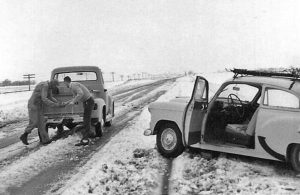 Before Interstate 80 was finished, the major East-West route through Omaha was Highway 30. Such local highways stopped in every little town so you could experience them. Except for that, we were making good time. The first sign of trouble may have been a snowflake or two on the windshield. But what the Heck, it’s springtime, March 24, and it’s not Minnesota — it’s Nebraska. What can possibly go wrong?
Before Interstate 80 was finished, the major East-West route through Omaha was Highway 30. Such local highways stopped in every little town so you could experience them. Except for that, we were making good time. The first sign of trouble may have been a snowflake or two on the windshield. But what the Heck, it’s springtime, March 24, and it’s not Minnesota — it’s Nebraska. What can possibly go wrong?
When it started snowing really hard, with no snow chains available, the car lurched from one rut in the snow to another, I blacked out in the back seat. When things got rough in those days, my brain, possum-like, escaped into deep sleep. The first time the Chevy skidded off the road, I sat up, wide-eyed and fully awake, “like a ghost,” as Lorin gleefully tells it today. We got help from a passing motorist in a pickup truck.
Later on, Doug drove us into a ditch. It was a long walk in a howling wind to the nearest farmhouse, but eventually we got a farmer with a tractor to pull us out. Chastened, we continued slogging west. A mistake was made, but from this point forward, we were certain nothing could stop us.
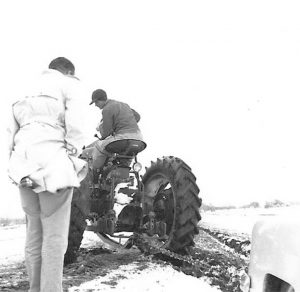 The snow got deeper. When Highway 30 became impassable near Kearney, NE, by quick thinking we dodged southward towards the Oklahoma panhandle. How bad could it be in Oklahoma? Seven miles from Oklahoma, we surrendered to the highway patrolmen and their “highway closed” barriers, and took a motel room in tiny Alma, NE. Here are some of the news reports still on the Web today:
The snow got deeper. When Highway 30 became impassable near Kearney, NE, by quick thinking we dodged southward towards the Oklahoma panhandle. How bad could it be in Oklahoma? Seven miles from Oklahoma, we surrendered to the highway patrolmen and their “highway closed” barriers, and took a motel room in tiny Alma, NE. Here are some of the news reports still on the Web today:
“March 22-25, 1957. 7500 motorists stranded in 8 state blizzard. Worst spring blizzard on record. Responsible for 11 panhandle deaths, numerous injuries, $6 million in damage. Texas Panhandle reported 30 ft drifts; Oklahoma Panhandle reported 15 ft drifts. Every highway in the western part of Kansas was closed by drifts of up to 10 feet and more. Local motels, churches and schools were packed with stranded travelers. Three passenger trains had become stuck in the storm; 20 percent of the panhandles’ cattle population was lost in the storm.”
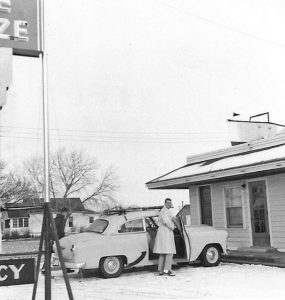 The next afternoon was sunny, as we waited in a line of cars and trucks stretching as far as the eye could see. When the snowplows got us moving again near McCook, NE, we passed some cars and trucks still buried under 8 foot snowdrifts. To make up for lost time, we would have to step on it. Aspen was calling. Yoo Hoo.
The next afternoon was sunny, as we waited in a line of cars and trucks stretching as far as the eye could see. When the snowplows got us moving again near McCook, NE, we passed some cars and trucks still buried under 8 foot snowdrifts. To make up for lost time, we would have to step on it. Aspen was calling. Yoo Hoo.
Watching the Rocky Mountains rise in the distance from the floor of the Eastern Colorado desert was an unforgettable thrill. Driving up from Denver and over 12,000 foot Loveland pass before there was any Eisenhower Tunnel was impressive. Barreling westward along two-lane highway 6, precursor of Interstate 70, our intrepid, college-educated, navigation team looked for the quickest way to Aspen. “It’s gotta be through Leadville,” we agreed. So we went south on 91 through Leadville. We crossed Fremont Pass, 11,318 ft, near the Climax Molybdenum mines, and headed for Independence Pass (12,100 ft).
There were large road signs clearly stating “Independence Pass. Closed for the Winter.” Our response. “Bulls**t.” How can one of the only two routes to Aspen be closed for the winter?” By the time we had driven for an hour up the winding mountain road and saw the wall of snow where the snowplows had stopped, we had our answer. Now we were 16 miles from Aspen as the crow flies. As the car drives it would be 120 miles of mostly mountain driving. Now it was after midnight and starting to snow again. No problem. We are invincible.
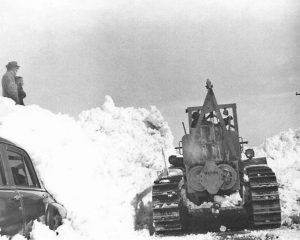 Coming down a series of steep switchbacks from Battle Mountain Summit (not far from site of 10th Mtn. Division in WWII) on Route 24 between Gilman and Minturn, Lorin loses control on the icy road and plows into a guard rail. This makes our third auto accident in two days. The fender was bent onto the tire so that the Chevy, teetering over a several hundred foot cliff, could not be steered. Using the tire jack, we were able to bend the fender enough to provide clearance, and forge ahead.
Coming down a series of steep switchbacks from Battle Mountain Summit (not far from site of 10th Mtn. Division in WWII) on Route 24 between Gilman and Minturn, Lorin loses control on the icy road and plows into a guard rail. This makes our third auto accident in two days. The fender was bent onto the tire so that the Chevy, teetering over a several hundred foot cliff, could not be steered. Using the tire jack, we were able to bend the fender enough to provide clearance, and forge ahead.
Back on Route 6, we head west in the valley sparsely populated in those days before Beaver Creek or Vail. Now it was my turn to drive. With lane markers hidden by snow on the winding two-lane highway, and wipers going full bore, I could maintain a healthy 15 miles per hour or so. Buses and semi-trailers kept passing us. How could they see?
After an hour of this, Lorin yelled, “Get behind that truck.” Soon I’m driving 50 mph closely behind a semi kicking up clouds of snow in our face. As long as I can make out his taillights, we’re in Hog Heaven. This went on for several hours. Later we become aware of the steep walls of Glenwood Canyon around us. The day breaks in a blue-gray fog, everything covered in fresh snow as we head up the Roaring Fork Valley from Glenwood Springs to Aspen. The only welcome for the Midwestern heroes was an upward glance from 3 or 4 mule deer chewing their cuds near the highway.
Step Two: Affordable Accomodations
We were desperate for a place to crash. We checked out “Ed’s Beds,” a legendary haunt for ski bums. It seemed to be a sweaty, snoring jumble of bunk beds. Anyway, it was full, and at $5 a night, way out of our price range. While I dozed in the car, Lorin and Doug found lodging more suitable for our budgets. Their secret: know somebody who has a hotel room, move in with them, and sleep on the floor.
Evidently we knew somebody. Soon we carried our gear up the creaky, wooden back stairs — sleeping bags, skis, poles, boots, clothes, food, and a balky Coleman stove. This hotel, an old brick structure in the center of town one or two blocks south of Main St., was some kind of annex run by a group of lawyer dropouts engaged in a perpetual party.
Step Three: Stylish Looks
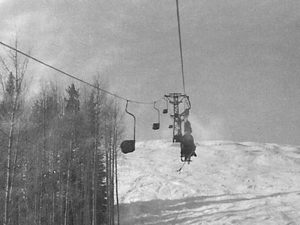 Among ski resorts, Aspen is especially fashion-conscious, so it is important to look the part. The previous year my scholarship was increased and I found myself with a refund check of $400, the most money I’d ever received all at once. Hence the latest 210 cm wooden Northland skis with segmented steel edges, cable bindings, and Ski-Free rotatable safety toe piece. Hence the Rieker laced leather ski boots with partial inner double boot. The Navy blue, gabardine, baggy-kneed White Stag ski pants, black leather mittens, and green duffle coat. Tie the red bandana around the neck, toss the rubber-lined leather imitation bota bag full of cheap wine over the shoulder, try the half-baked yodel, and you’ve got style, style, style. Get ready, Princess Jasmine.
Among ski resorts, Aspen is especially fashion-conscious, so it is important to look the part. The previous year my scholarship was increased and I found myself with a refund check of $400, the most money I’d ever received all at once. Hence the latest 210 cm wooden Northland skis with segmented steel edges, cable bindings, and Ski-Free rotatable safety toe piece. Hence the Rieker laced leather ski boots with partial inner double boot. The Navy blue, gabardine, baggy-kneed White Stag ski pants, black leather mittens, and green duffle coat. Tie the red bandana around the neck, toss the rubber-lined leather imitation bota bag full of cheap wine over the shoulder, try the half-baked yodel, and you’ve got style, style, style. Get ready, Princess Jasmine.
Step Four: Stylish Ski Technique
I learned basic skiing using the rope tows at Buck Hill in Burnsville, Minnesota, vertical, 300 feet. I read ski instruction books, watched Warren Miller movies and international ski racing on TV. I was hooked. But I had never seen a mogul (a rounded mound of snow a foot or more high, usually large numbers of them covering entire slopes). I’m trying to make a perfect stem christies right out of the book by Ernie McCullough and, What the f**k! My skis are suspended by tip and tail while I make a perfect face plant. Ernie, you never wrote about this s**t!! I need to take a lesson even if it busts my budget.
There were four chair lifts on Ajax mountain. (Buttermilk, Highlands, Snowmass and the other Aspen ski areas did not exist.) All single chairs. I remember paying either $3.00 or $3.50 for lift tickets, possibly student or end-of-season discounts. With lift lines taking an hour or more, this was not such a bargain. A half-day group lesson cost another $3.00 or $3.50.
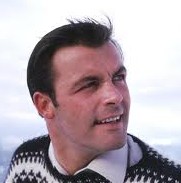
Toni Sailer
To be a ski instructor at Aspen in 1957 you had to be handsome, deeply sun-tanned, hatless, and preferably Austrian. Mostly because the Austrians kicked ass in every ski race. In the 1956 Winter Olympics in Cortina, Italy, Toni Sailer, a 20 year old with movie-star good looks, brown eyes, and swept-back, long, black hair, had won gold medals in every alpine race for the first time in history. He destroyed the competition, winning the slalom, giant slalom, and downhill by more than 4, 6, and 3 seconds respectively. The Austrian technique could be done right only by Austrians. It was a chiropractor’s dream come true. Put both feet together with no snow showing between your skis, as if you have only one leg and a monoski. To turn left, rotate your whole body left, except at the last minute, crank your spine 30 degrees right to avoid hitting the slalom pole. When executed properly you hear the CRACK of your vertebrae.
Ski instructors did not have to speak a word of English. In fact, my instructor gave an entire lesson using only the German word “Ja.” From his tone of voice and body language you could figure it out. Ja, meant ‘Not Bad.’ Jaaaa (shaking his head) meant ‘Not Good.’ Jaaaaaaaaa (shaking his head and wagging his finger) meant ‘Really Crappy.’ Jawohl meant ‘Fantastic!’
Ten years later, demand for these Austrian demi-God instructors collapsed, thanks to Jean-Claude Killy, who changed everything with his new, wide-track French technique. Meanwhile, our Advanced Intermediate group was learning to rotate the shoulders in the same direction as the turn, and how to turn on top of moguls so as not to get stuck between them. After we finished off on Ruthie’s Run, we felt “What a great lesson!”, and “What a confidence builder!”
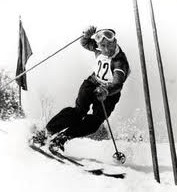
Christian Pravda Torquing Spine
One day I was outside the Octagon House on top of Ajax Mountain, and who did I bump into? None other than my idol, the ultra-God Toni Sailer, standing there in his blue Bogner stretch pants, thick, yellow, cabled sweater, and cool shades, wrapping his longthong Marker bindings. He was accompanied by Anderl Molterer, the blue-eyed, handsome Austrian with long, swept-back blond hair, who had won several silver medals in Cortina behind Sailer the previous year. Christian Pravda, a slightly older Austrian ski champion was also in the group. Hundreds of spectators lined both sides of the run like a golf gallery, waiting for a glimpse of these super skiers.
They were not disappointed. Like a shot, the threesome raced down the mountain, legs together as if on one leg, fast wedeln moves, snake-like hip action, split jumps off moguls, and the occasional Reuel (or “Royal”) Christie, raising the downhill ski completely off the snow like Peggy Fleming. It was breathtaking. Wow!! I vowed right there that if I did nothing else in my life, that I, like my deceased father, would become an expert skier. (After some 500 days in my lifetime skiing throughout the US and Europe, including some veteran racing, I did keep the promise.)
Step Five: Take in the Atmosphere
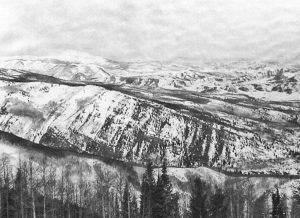
View westward from Ajax chairlift
I was completely swept away by the Rocky mountain scene, and fell in love with the Aspen aura. The way it snows a few inches of powder almost every night. Aspen’s beautiful women. My first sight of stretch pants, the end of baggy ski pants. It was amazing how good it made people look, e.g. women buckling their boots. European accents were in the air. The high altitude produced very deep suntans because of the intense UV light. Most people wore zinc oxide on their lips and noses, and the unmistakable scent of “Sea and Ski” suntan lotion was everywhere.
In 1957 Aspen still showed its humble beginnings as a silver mining town, and a few things were affordable. When we weren’t heating up canned goods in the hotel room, we actually had a few dinners out in decent restaurants. One night I remember dinner at “Guido’s Swiss Inn” and another at the “Golden Horn”. We had some after-ski beers at the famous “Red Onion.” I really enjoyed my first Coors Beer — available then only in the Rocky Mountains.
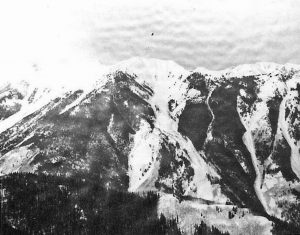
View west from Ajax mountain includes the top of future Aspen Highlands area. A high-soaring bald eagle is captured in the photo.
Then I had another glimpse of Royalty — Minneapolis Royalty. Through the window, having a candlelight dinner at a nice restaurant, I caught a glimpse of Sue XX, a gorgeous, pony-tailed brown-haired, blue-eyed babe that worked in the same office as me one summer, and whom I loved from afar. In those days I deliberately sought out rejecting or otherwise unavailable women. Sue lived not far from me in Southeast Minneapolis. The few times I ever spoke to her she had always been friendly, but she came from money. I lived in a poor neighborhood, and she lived on the exclusive River Parkway by the Mississippi. I knew she was at the U. of Colorado, Boulder, and couldn’t help wondering how she was getting along in Aspen.
Step Six: Act Like You Belong There
The only trouble with being a ski bum is that at times you feel like a bum. It takes a lot of self-confidence to pull off a week’s lodging without paying. Lorin and Doug were smooth and debonair. Perhaps my Bible Belt upbringing was holding me back. Something told me that any day now we could get a knock on the door followed by a Sheriff’s escort out of town, perhaps with a fresh coat of tar and feathers.
It came to a head one night when we were about to heat up dinner in our hotel room. I forget, but it could have been canned Spam, Chef Boyardee Macaroni and Cheese, or one of my favorites, “Beanie Wienie”, baked beans with little wiener segments. Umm…good. WHOOSH went the Coleman stove. Flames shot 3 feet high as Doug tried to get it started. “How long would it take for this old firetrap to go up in smoke?” I wondered.
Lorin and Doug were aiming for bigger things. They had been scoping out the Hotel Jerome a block or two away, the classiest and most expensive hotel in town. It had a heated, outdoor pool, clearly marked “For Guests Only.” Lorin and Doug had their swimming suits ready to go for a swim there after dinner, and asked me to join them as I crawled into my sleeping bag and blacked out.
Step Seven: Return Home
On the way home we stopped for a half-day of skiing at Arapahoe Basin. With a summit elevation of over 12,500 ft, it had better snow than Aspen, but we got caught in a complete white-out, making it very hard to know up from down. We drove without incident to Omaha, and I hitchhiked back to Minnesota. My total expenditures for the whole vacation, no joke — $55.
Step Eight: Stop Being Such a Bum
When you come to Aspen, or any other resort, look for deals, but if you can, pay full price. You’ll sleep better and have a lot more fun.
Jim Sudmeier
Revere, MA
first draft Jan. 6, 2010
